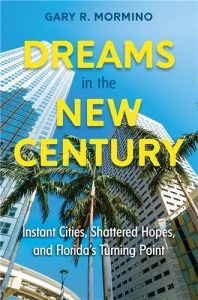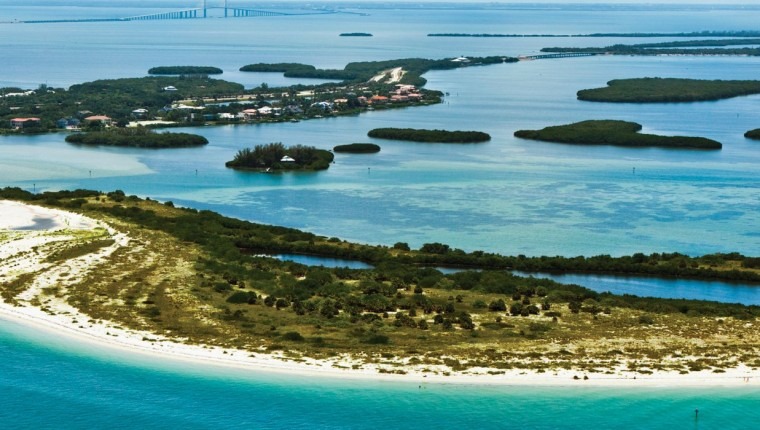October 4 at 6:30 pm
Free
Palm Harbor Library
Details here
Condos overlooking the Gulf of Mexico seemed a perfect match in a state where demand exceeded supply.
Beginning in the 1960s, the rush began to smother the Sunshine State’s waterfront with condominiums. To create more supply, savvy investors created a new way of selling a slice of paradise – the two-week time-share condominium.
No place did this new way of living seem more out of place than the barrier islands of Tampa Bay. Saltwater mosquitoes, inhospitable islands and transportation challenges ensured that places such as Cabbage Key remained largely untouched until the 1960s. The past is prologue.
In 1913, a land syndicate purchased Cabbage Key, a 300-acre island off Pass-a-Grille, a barrier island. Longtime residents guffawed when they learned the new owners paid $5,000.
Engineers converted a “large houseboat” into a dredge, “which will be used for the dredging in the vicinity of Coon Key and Cabbage Key . . . A large amount of sand will be pumped on the islands filling in some low places near the shore.” The new town would not appear for half a century.
In 1948, Life magazine discovered Cabbage Key. Readers found the lone inhabitant more interesting than the cabbage palms and mangroves. Overnight, the white-bearded Silas Dent became the “Hermit of Cabbage Key.” Author Hal Boyle described Silas as “Santa Claus gone to seed.” Dent was occasionally joined by the heart-broken and soul-crushed who sought his companionship and solitude.
He liked to make Christmas presents from shell and wood and deliver them to poor children. He was also joined by the island’s citrus rats. To combat the latter, he imported cats. His legs revealed many rattlesnake bites, the only animal he killed. He never wore shoes.
Soon, “Old Silas” Dent would be best known as the name of a restaurant. The angelic hermit would not have approved. Old Silas Dent’s Steakhouse & Bayside Bar at 5501 Gulf Blvd. [in St Pete Beach] paid homage to him, not the epic dredge-and-fill that created a new city lined with condos and vegetation that did not belong. Dent remained on the old island until his death in 1952.
A modern stampede occurred along the Pinellas Gulf Coast in the decades after WWII. Along what once was miles of undeveloped coastline, developers imposed their will, constructing finger islands and seawalls. Developers transformed cheap, submerged lands into waterfront property, commanding the technological wand of massive hydraulic dredges that piled bay muck into real estate.
Tierra Verde may have marked the most dramatic chapter in the high-stakes dredge-and-fill derby. The project was so immense that the New York Times announced the audacious plans to build a city on 15 uninhabited keys on Boca Ciega Bay.
Several prominent developers purchased Pine and Cabbage Keys for $2 million. Texas oil tycoon and NFL owner Clint Murchison became part of a group that purchased 1,800 acres and the rights to their submerged lands for $12 million.
Federal, state, and local transportation projects made this ambitious development possible – the construction of the Sunshine Skyway Bridge, a 15-mile structure spanning Lower Tampa Bay, connecting Manatee and Pinellas counties. To make the project more “public,” the projects promised motorists access to Fort De Soto Park and Beach.
In 1958, the first dredges began to convert land from water. The syndicate named the new city Tierra Verde (Green Land). The vision included golf courses, shopping centers, schools, yacht marinas and a helicopter port.
In 1959, investors sold the Tierra Verde Corporation to New York building mogul Louis Berlanti for $6 million. A local journalist described the impact – “A huge concrete batching plant stands silhouetted against the sun. . . . Seawalls are taking shape . . . What were once the islands of Pine and Cabbage Keys . . .”

– photo courtesy of Visit St Pete Clearwater
Not everyone applauded the ambitious plans to alter the face of bay and beach. Local and state opponents criticized the project for its finances — some argued the project amounted to a massive giveaway of free roads for private gains; others understood the environmental implications of dredge-and-fill that was ruining Boca Ciega Bay. With the opening of bridges and highways, legions of cars were arriving by the early 1960s.
The developers won the battle. Massive construction transformed and consolidated 15 isolated islands into Tierra Verde, incorporated in 1961. By 1962, a road and bridge connected the new city to the mainland.
The Pinellas Bayway connected the island to St. Petersburg and the Gulf beaches as the fanciful Guy Lombardo’s Port-o-Call Hotel and Motor Inn opened on Tierra Verde.
Berlanti persuaded Lombardo to open a nightclub before his mysterious death on a sabotaged aircraft. Guy’s orchestra dedicated the opening in January 1963.
Guy Lombardo was an acclaimed bandleader known for his touring band, the Royal Canadians. For a half century on radio and television, he hosted a popular New Year’s Eve show.
A part-time investor in the property, Lombardo touted this swank Pinellas destination while touring. The new digs gained national fame when showcased on a 3 May 1963 episode of the popular Route 66 television show.
By the early 1980s, Tierra Verde Island Resort enjoyed its reputation as a high-class time-share. Picnics, volleyball contests, boat rides to nearby Shell Island, and other amenities lured both locals and those far away to buy time-shares. But in the early 2000s, a growing number of owners passed away or stopped paying their maintenance assessments.
The Great Recession sheared away any confidence for buyers burdened with time-shares. Conditions deteriorated. Soon, owners received notices that their condo association had plans to disband for new developments.
At meetings in 2006, some elderly owners who flew down for contentious association meetings learned the hard truth of time-shares. Investors had quietly purchased many weeks that had lapsed or fell into receivership for pennies on the dollar and held enough votes to disband the association before its official end in 2020.
Time-share weeks purchased for a few thousand dollars in the early 1980s were now valued at $100 for the lucky, while many received nothing. The Tierra Verde Island Resort closed, wrecking crews bulldozed the site, and some former owners continued to receive letters promising to help them unload their zombie time-shares.
Guy Lombardo’s Port-o-Call was demolished in 2007. Preservationists saved the mural that featured portraits of Mel Torme, Marlene Dietrich, Frank Sinatra, and others who helped make the site even more desirable.

This is an excerpt from Dreams in the New Century: Instant Cities, Shattered Hopes, and Florida’s Turning Point winner of the Florida Book Awards Gold Medal for Florida Nonfiction by Dr. Gary R. Mormino, the Frank Duckwall Professor of History Emeritus at USF St. Petersburg.
Gary Mormino will be speaking at the Palm Harbor Library on October 4 at 6:30 pm, hosted by the Palm Harbor Museum. You can RSVP for this free talk here. Donations gratefully accepted.





